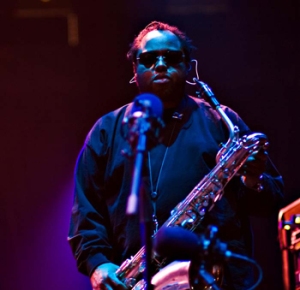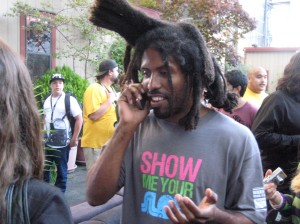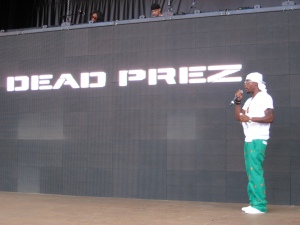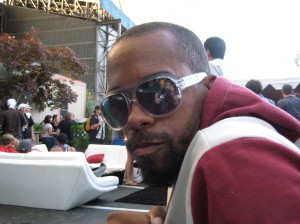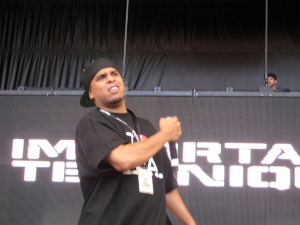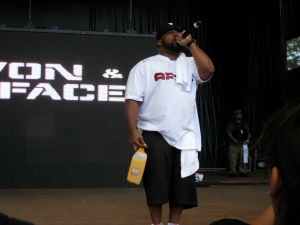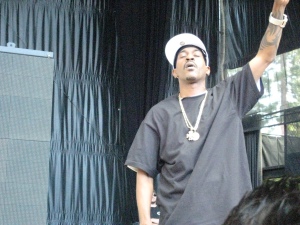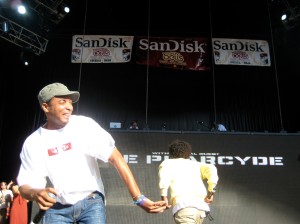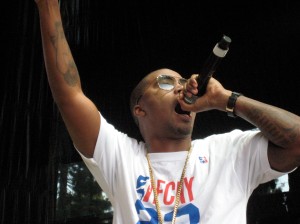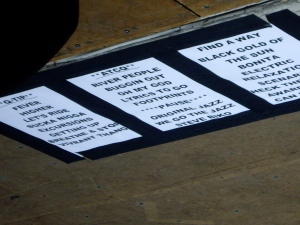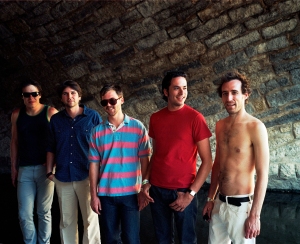
TMTS
It’s always nice to see the story of a local person doing good, and in the case of Evolving Music and MixMatchMusic, two entities growing into the music industry out of the Peninsula Bay Area, seeing our long time friend, Scott Reitherman, grow in success with his new group Throw Me the Statue out of Seattle has been an excellent journey. From the first show we saw as an opening act for Jens Lekman at Bimbo’s 365 club, the inclusion in the Take Away show phenomenon, to his Rhapsody commercial and now a music video for their song “Lolita” on MTV2, the growth of the band and the potential for them to turn into actual stars has reached a high pitch. Following positive reviews of their debut album Moonbeams on Stereogum and Pitchfork Media, Scott sat down with me to talk about the transition from a self-started label to an Indie label, the process of making music and the new and changing landscape of the current music industry. Enjoy!
AC: The music on Moonbeams has a wide variety of instrumentation and genre influences in there. Talk for a minute about your musical influences and what you listened to growing up that still speaks to your music writing today.
SR: With Moonbeams I was in a spot where I was trying to make a debut record that would show that I do listen to a variety of music. I didn’t want to make a record that was going to be easily typecast, I guess not typecast, but I mean to say I didn’t want to make something that would fit in a box easily. I also wanted to make a record that various people might be able to hear because they might like a song here or a song there, and sort of give something for everybody, if that wasn’t too lofty of a starting point to attack it from. So that’s what I did, and I tried to make it a collage of aesthetics because I do listen to a variety of stuff.
When I was first starting out buying CDs in the 3rd or 4th grade, I definitely had a strong pop mentality. At first it was a serious obsession with New Kids on the Block, which transitioned into Beastie Boys, Paula Abdul, Boyz II Men, Bobby Brown… Bobby Brown being a part of the record collection.
AC: Some of our readers are rolling their eyes right now.
SR: Yeah. When you’re a kid, that stuff just hits on an instinctual level. You don’t realize how overprocessed it is, but it was a while before I finally started listening to what people think of as Indie music or stuff that falls underneath that umbrella. More in college I guess I started finally getting turned on to the bigger Indie bands of the day and doing some homework and going back in time, catching up on stuff I needed to know about or needed to understand the history of Indie. I think looking back on high school, I wish I had listened to a wider variety of stuff, but I think that’s a product of coming from the California peninsula and having a slightly homogeneous cultural background with that.
AC: Talk a bit about your musical development in terms of your instrumentation. Did you start classically with a piano or guitar, and how have you gone about learning new instruments and incorporating them into your style?
SR: I learned how to play guitar at summer camp when I was in the 6th grade. Basically I stuck with that for probably 6 or 7 years. Along the way, my brother started taking drum lessons and for a couple years, my brother, who’s younger than me, had a drum kit in his bedroom and I immediately took to that and started playing his drums a lot more than he would play them. When he stopped taking lessons, the drums went away and I didn’t pick back up with drums or any other instrument until college when I started fooling around and teaching myself piano through my knowledge of guitar.
From there, learning and playing other instruments just became a necessity to make your own recordings and be able to have different instrumentation on there if you didn’t have a band with a bunch of multi-instrumentalists behind you. So drum machines were also a product of that, because when I write songs, I usually do it with a drum beat off of an old keyboard just as a backbone to help facilitate the whole creative process of trying to write a song. You put something like that down and then you just sort of play and riff on whatever it is you’ve come up with that afternoon. So leaving the drum machines in the recording was something I had grown accustomed to and really liked, but was also a way to reveal the process. Did I miss anything there?
AC: Well you covered the drums, the piano and guitar. You’ve got some really interesting instruments on Moonbeams. How did you pick some of those up.
SR: Well some of those like glockenspiel are just based off of piano key configuration, so piano to glockenspiel is a pretty short jump. Some of the other stuff I had friends help with. Like horns, we hired some horn players…I can’t play anything on the horn. Melodica is on there a lot, melodica is also based on the key configuration of the piano, so blowing through that and playing the keys was a short jump from piano. I don’t know if this is how most people go about it, but having a foundation in guitar and piano leaves you with a pretty good skill set to pick up other things and have it sound acceptable.
AC: What people that have picked up TMTS in the last couple months as you guys have grown in popularity probably don’t know about is your previous work in bands. Talk a little bit about your history when it comes to the groups you’ve played with and how have those experiences helped shaped your direction with TMTS.
SR: I guess it started out, aside from a short stint in a band that wasn’t really a band in middle school that probably sounded a lot like Bush, in high school we got more into eclectic instrumentation, playing with guys that played the horns and doing music like ska and funk and more straightforward rock laid the foundation for really appreciating various instrumentation and how you go about orchestrating a handful of sounds on one song. But I would say that the stuff that I did in high school with bands was really influential in certain realms like how do you exist in a band, how do you navigate that familial relationship with other people and group creative process. All of that is something that definitely takes practice in figuring out the harmony and the balance. So that was really good in the sense that it prepared me to play in bands later. But musically, there was a big shift in my taste once I got to college. TMTS has made me acceptable to some peoples’ ears because it sort of pulls from both of those periods from me. One would be the rooted in pop accessible kind of mainstream stuff, and the other would be the recent shift in the last 5 years or so of listening to avant garde and more Indie music.
I read a couple things where people said that Moonbeams sounds like it could be a ’90s rock band, I think that’s kinda funny because I didn’t really anticipate that, but maybe it is sort of accurate because that was the period of rock music that I was listening to a ton that was my first roadmap to figuring out what I wanted to do musically.
AC: What would you say stylistically the change was for you between Moonbeams and Liberty Market Summer.
SR: Wow.
AC: Come on, you gotta bring up Elephant Blend here.
SR: Yeah, you brought it up! That album had a more homogeneous sound from song to song, and it was rooted in a feel good California setting. Both the lyrics and the tone of a lot of those songs was a little bit sunnier and maybe a little bit more naïve. And there’s nothing wrong with that, because young people are usually a little bit more naïve than they turn out to be later. Not to say that Moonbeams is a cynical version of that record, but I would say that Moonbeams felt more mature, and lyrically I would hope it is much more mature because Liberty Market Summer was the first record that I ever sang on. I was always timid of being the singer.
When you start bands in high school, it was like a revolving cast of people who were the singers and I always played guitar. At some point I finally made the shift in courage to sing the songs that I was writing already. I think that settling into that and figuring out how as a singer I was going to establish my voice in a way that felt authentic and earnest and accurate was the biggest challenge in doing Moonbeams. For me, if I were to, and I haven’t in a while, listen to Liberty Market Summer, I would probably at first cringe to hear myself sing because it would sound like a very different version of my self. Not because that was disingenuous or inaccurate, but it wasn’t as thought out.

Scott Reitherman
AC: You guys came out on Baskerville Hill and obviously that was a pretty big step for you because you had to basically launch the label yourselves and not only record, but promote and put out these albums. What was the process of getting signed to Secretly Canadian like, and how did the preparation for getting signed differ from putting out the album and doing the work yourself on Baskerville Hill.
SR: In terms of the preparation for getting signed, there wasn’t really much preparation at all. We were in the midst of releasing Moonbeams on Baskerville Hill in the first couple months and were fully intending to put it out ourselves just like we had done with our other releases before it when Secretly came out of the woodwork and approached us about it. So we were hiring a publicist for the first time to work with Baskerville Hill and help spread Moonbeams further and in the process of doing that, I think it was two months after we had put it out on Baskerville that we got an email from Secretly.
I don’t mean to gloss over the fact that I had given a friend of mine who plays in a band on Secretly Canadian a handful of copies and said, “give these to whoever you want,” and one of the ones he gave out was to those guys. So we knew that it had at least landed on their incoming mail desk, but having not heard anything for two or three months after that, we weren’t thinking much of it at that point.
AC: A lot of people who are musicians and getting into it, hoping to make some sort of career and life out of their music, they probably think that once you get picked up by a label, everything changes. How has your day-to-day life actually changed from releasing it on Baskerville Hill to now being a part of Secretly.
SR: Well, I do less mailing at the post office everyday. That was probably the biggest shift. Everyday at about 4:45 I would rush off to my local post office and get in line before 5pm when they closed the door and mail out the orders for Moonbeams. And that went on for what seemed like a very long time. I was always doing the mailing of our orders up until then, but with Moonbeams the packaging upped a little bit. We started including posters with it, and we were getting a fair amount of orders at the beginning. So a chunk of my afternoon was devoted everyday to wrapping up the orders and shipping them out.
That was fun, I liked writing messages on each one to the people that would order them, and the amount of personal connection I felt with these envelopes going out into the world was special. But it’s also nice to not have to deal with that end of the process of releasing records anymore, at least for now, it’s nice to just concentrate on the music itself and steering the band in a direction that’s going to be happy and good for us. So now I do more emailing. I get a fair amount of email from the label each day regarding various things that we can say yes or say no to. Like, “Do you want this BMX video to get your song in it? It won’t pay you anything, but it’s kinda a cool thing to do.” So we’ll say, “yea, that sounds cool, I used to watch videos like that as a kid, I think it’d be totally hilarious if one of them used one of our songs, I think that’s cool.”
Once in a while they’ll say, “Do you want us to try and pursue this advertisement on television for you guys and maybe get you some actual money?” And we’ll say, “Well, depending on what it is, we would love actual money.” You don’t get paid as often as you do when you receive the credit cards over your own record label’s website and mail them out yourself. Now we get paid every 6 months from the label, so we have yet to be paid anything and I think July is our first pay cycle, so hopefully we’ll get some small sliver of a check because it’s the whole thing about how they have to recoup the budget that they put into it first before we get paid anything. So I would say, at least this summer, my day to day life is pretty good. I’m just working on music, trying to get the next batch of songs all sketched out and demoed and then soon we’ll get together as a band and start to move on to track final versions that will end up on the next record before we go out on tour. We’re also working with a new band member right now, so part of our time is spent getting him in the loop.
AC: Talk a bit about touring and what goes into it. What does the average fan not know about a musician’s tour?
SR: What it’s actually like to spend weeks on end in a 15 passenger van with your band mates without showering. What it’s like to get your morning coffee at a gas station more often than not. How hard it is to get up early and get back on the road for another 8 hour drive after you played a show the night before and didn’t get to sleep on time. I would say what people think or what they anticipate that they would like about the touring process are the exciting parts of it, which are playing that many shows and meeting that many new people and engaging with real people through your music is way more amazing than I could have even imagined. But the constant travel and the element of the road trip sometimes being a lot less laid back than you get to make your other road trips in life is the element you don’t quite expect.
AC: You’ve obviously, the past couple months, gotten a good deal more recognition with publications like PitchFork Media and Stereogum, you had “Lolita” in a Rhapsody commercial and now you’ve got a music video for it on MTV2. What has this process been like and has it changed the way you looked at the music industry when you were in high school and college?
SR: I think that even when we were in high school and college, MTV was on its way to phasing out music videos and phasing in reality shows. But I would say that now, when we heard we were going to get our video for “Lolita” on MTV2 it was still a trip, and then they were like, “It will be on once at 1am on Sunday.” And we were like, “Oh… ok.” So it’s pretty fun, and it was fun to make the video. We had a lot less to do with the production of it than the director and the actors that were in it did, but it’s an interesting glimpse into how the Indie music industry still maintains this sliver of MTV’s attention. It’s sort of funny, it seems like too small a niche within MTV’s programming world to even matter at all. But this one Sunday night show where they show Indie music videos is a hanger-on and I hadn’t really paid attention to this show Subterranean before, but they actually have pretty awesome videos each week. It’s kinda sad I guess, but I guess it is what it is.
AC: You were saying earlier that you have yet to see your first check from Secretly. Could you discuss the difference in terms of sales and profits between your self-promoted efforts, Secretly Canadian, and sales on iTunes. Do you have any way of quantifying or describing that right now? I think a lot of people, and specifically the record labels are pushing this point of view that if you’re buying a 99 cent song on iTunes the artist is getting a good portion of that or somehow the artist is not being stolen from when really the reality is the amount that the labels give artists of that is slim. So anything you could talk about the difference in your experience in terms of revenue and sales.
SR: As far as I understand the iTunes business model, when you buy a .99 cent song, the artist, if they’re with a label, hopes to get about a third of it. iTunes takes a third, first and foremost, and of the remaining .66 cents, the label hypothetically takes a third and the artist takes a third, in the case of the kind of label that we’re on which is a pretty artist friendly situation. There’s digital distribution company that may be a middle man there and may be taking a cut.
With us, Secretly has a pretty unique arrangement where they own their own distribution company as well as their own record label and they’ve built that up over the dozen years that they’ve been in business to a pretty good place. So they’re able to maintain some of those percentages that otherwise they might have had to pay out to another distributor. As far as the difference between releasing your own record and having someone else release it and how the shakes down, it’s no surprise that a record label, especially an Indie that doesn’t have huge money bags lying around, they’re going to have to pay you every so often, so for us, it’s on a 6 month pay cycle. If people think that when they buy a song on iTunes that the artist is getting a bunch of those .99 cents, that’s probably not true. It’s hopefully more true if they’re buying from an Indie artist versus a major label artist, but what is that really worth because a major label artist is probably selling more one-off mp3s on iTunes and in the end they’re probably making significantly more money if they’re a good selling major label artist than a medium selling Indie artist.
AC: Moonbeams just being released, and you being relatively new to the industry, but for a few years now we’ve seen a very vicious downward cycle in terms of actual physical CD sales, and the major record labels have started to freak. Have you, being a part of the music industry, seen this type of erosion, and what’s it doing in your mind to the traditional record industry?
SR: That’s a really good question. I guess I don’t know how much interest I have in the decline of the major label record industry. I think what will be interesting to see is how musicians figure out a compelling way to release their music that will re-engage people who love music. I mean, everyone loves music, but what it’s up to the record labels to do now is to figure out a way to bring that new music to the people. It’s not pirating’s fault, but the information age and the internet have ushered in a huge variety of new variables with how you sell art and obviously it’s turned out that people are de-valuing music left and right.
And again, it’s not pirating’s fault, it’s just one of those things that major labels didn’t react quickly enough to. So if it’s not the CD and it’s not the vinyl record, what is it going to be that will get people to financially support artists again? I think that would be interesting. I would love to see bands start releasing books that come with download links to the mp3s themselves. If people don’t care about these little 3.5″ in diameter floppy plastic discs anymore that we call CDs, and there’s no reason they should because it was a crappy format to begin with, then give them something else, something more, maybe a collection of photographs or writing. Just more content that’s going to re-engage people on a personal level with their favorite artists so that they do feel they want to have a hard copy as opposed to the mp3 download that any person with any amount of sense can figure out how to get without paying for it.
AC: I think that on that same note, a large portion of the problem is that maybe consumers got fed up with the fact that these record labels for so many years, while I wouldn’t want to say overvalued music at $17-$18 dollars a CD when it took a buck and a half, two dollars to make, but they certainly fought pirating and mp3s with this passion that somehow the consumers were stealing from the artists. But when you look at the kind of royalties and shares that the artists actually got off of those sales, the record labels were taking a huge chunk out of that and maybe the consumers got sick of hearing how they were stealing from the artists when really they felt they were only stealing from these multi-billion dollar corporations.
SR: Well I would love to think that that’s true in certain peoples’ cases, but I think that’s a little too generous to attribute to the masses. It’s sort of like if there were a riot and the police were the major labels and everyone else were the people rioting, and some people had the consciousness to go to Best Buy and break in and steal stuff that they wanted to because they saw it as an evil corporation, or better yet they went to KMart and they broke in and looted Kmart because it was political for them to do that. The vast majority of people that would follow suit get wrapped up in the energy of that riot, or the mindset of it, or the carelessness of it, they would loot from whatever was easiest which would be the Mom and Pop stores, or maybe in this case the Indie labels because there are many more Indie labels than there are major labels. So once you set off that kind of chain reaction, it’s hard for people to care whether or not what they’re doing anymore is right or wrong because it’s just so easy and everyone else is doing it.
AC: As the Internet becomes more collaborative with greater access worldwide, not only in terms of more economic classes being able to access it, but also in terms of the speed with which you can do things online, do you see a shift coming where more music will be made online, and how do you envision that happening? Obviously the focus of this question is what the folks over at MixMatchMusic are working on.
SR: Definitely. I think it’s a no-brainer to see that kind of thing on the horizon. There’s been so many successful examples of that type, if not specific collaboration in music these days, at least the mixing of cultural sounds and cross-cultural musical aesthetics. There’s a lot of bands and artists who have a foreign sound mixed with an American pop backbone like MIA or Santogold, who’s American. Postal Service is a great example of a couple of guys who are living states apart mailing each other beats and vocal overdubs and came up with a platinum record. The Internet is going to make things like that so much easier, well it already has, it’s kinda silly to talk about it in the future tense, but for MixMatch and companies that are trying to facilitate that even further, I hope that it’s going to revolutionize the way that strangers are able to make music together, or people who are coming from really various backgrounds collaborate. But I do think that the other element of that is what you’ve seen with Radiohead recently where they commissioned a remix series and offered up the different parts of one song to their fans to fill in a blender and spit out as they wish a new version of the song is a really fascinating example of what the Internet can do these days if they present it to the people in the right way.
AC: Is that a type of remixing project that you could see yourself getting involved in?
SR: Maybe down the line. Right now, I’m too busy and self-absorbed with the next record, not to sound like a jerk, but I’m trying to focus right now on a new batch of work and we just participated in a couple of cover projects already, so we’re kinda coming off of that and refocusing our energies.
AC: To finish up, in terms of refocusing your energies and your efforts, what kind of stuff are you working on now and what is your writing process like in general?
SR: Well this time will be different from the last time. Last time was a solo effort and took a while to build up the songs and having complete control over how they turned out is something that I don’t want to do this time around. It’s different in that this time around, I’m basically coming up with demos or sketches of the songs that I’ve been kicking around and working on since Moonbeams got completed, and I’m in turn giving burned CDs of those to the guys in the band and seeing which ones they respond to and which ones they want to work with and figuring out how we’re going to whittle it down to a workable track listing to pursue for the initial stages of tracking the record, then go from there. Not write all the parts this time, write the parts that I have been coming up with then leave it there and let them add on to it which will make it more of a group effort. So it’ll be interesting, it will be the first time in a while that I’ve done something like that, and I think it will be better because of it.
AC: Now is that process something that is made even more comfortable by the fact that one of the guys you deal with, Aaron Goldman, is someone you’ve been working with musically for quite some time now?
SR: Definitely. He and I went to high school together, and we connect very easily on a lot of levels, and in regards to the songs this time around it’s going to be really fun to see what he comes up with. I know the rest of the guys are going to be coming up with a lot of brilliant stuff, and I’m really excited to step back from the construction of these songs a little bit and really see which direction they end up finding their way.
AC: When can we expect this album… any sort of time table yet?
SR: I think it’ll be middle of next year.
AC: I’ve had one person close to me suggest that you should title it Sunrays.
SR: {laughter}
AC: {more laughter}
SR: I hope you didn’t land any money on that.
AC: No, absolutely not, I didn’t think it was a winner. Scott, we appreciate you taking the time to talk to us over here at Evolving Music. Do you have anything you want to talk about or plug, any upcoming concert appearances or anything you want your fans to know about?
SR: We just did a Huey Lewis cover tune. I recommend people check it out if they want a dose of ’80s nostalgia.
AC: Which one did you cover?
SR: “If This is It.”
AC: Where can they find it?
SR: Ye olde myspace page, www.myspace.com/throwmethestatue.
